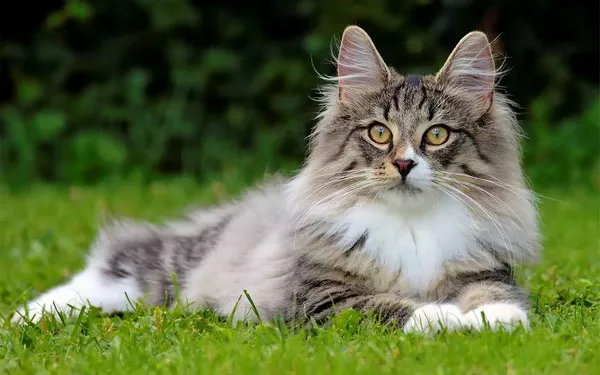The Norwegian Forest Cat, with its majestic appearance and resilient nature, is a breed that often captivates the hearts of cat enthusiasts. Known for their thick, water-resistant coats and rugged background, one might wonder how they handle water-related activities, particularly baths. While it may seem counterintuitive to imagine a cat enjoying a bath, understanding whether Norwegian Forest Cats like baths requires exploring their physical characteristics, behavioral traits, and the various factors that influence their comfort with water. This comprehensive article will delve into these aspects to provide a clear answer to the question: Do Norwegian Forest Cats like baths?
Understanding the Norwegian Forest Cat
To fully appreciate the relationship between Norwegian Forest Cats and baths, it’s essential to understand the breed’s origins and characteristics. These cats have evolved to thrive in harsh Scandinavian environments, which has significantly influenced their behavior and physical attributes.
Physical Characteristics
Norwegian Forest Cats are known for their large, robust bodies and thick double coats. Their fur consists of a dense undercoat and a water-resistant top layer, designed to keep them warm and dry in cold, wet conditions. This natural adaptation suggests that their ancestors had to deal with damp environments, but it does not necessarily imply an inherent fondness for being wet.
Behavioral Traits
These cats are renowned for their independence, intelligence, and playful nature. They are natural climbers and hunters, which reflects their need to be agile and adaptable. Although Norwegian Forest Cats are generally good at grooming themselves, their behavior towards baths can be influenced by their individual experiences and comfort with water.
Do Norwegian Forest Cats Like Baths?
Determining whether Norwegian Forest Cats like baths involves examining their typical reactions to water and bathing experiences. While individual preferences vary, there are general trends and observations that can provide insight.
Natural Instincts and Historical Context
Cats, in general, are not known for their love of water, and this applies to Norwegian Forest Cats as well. Historically, domestic cats, including those from the Norwegian Forest breed, have not needed to swim or bathe as part of their survival. Instead, their grooming behavior has evolved to maintain their coat’s cleanliness and health.
The Norwegian Forest Cat’s dense coat is designed to be self-cleaning to some extent, which means they do not typically require frequent baths. Their historical context as semi-wild creatures further influences their behavior toward water, making them less inclined to enjoy or seek out baths.
Individual Preferences
While Norwegian Forest Cats have physical traits that could suggest an affinity for water, individual preferences play a significant role in their reaction to baths. Some cats might tolerate or even enjoy water-related activities, while others may find them stressful or unpleasant. Factors such as early exposure to water, past experiences, and personal temperament all contribute to how a cat will respond to a bath.
Factors Influencing a Norwegian Forest Cat’s Comfort with Baths
Several factors can affect a Norwegian Forest Cat’s comfort level with baths. Understanding these factors can help in determining how to approach bathing and ensuring a positive experience for the cat.
Early Exposure to Water
Kittens that are gently introduced to water at an early age may be more comfortable with baths later in life. Early exposure can include positive experiences such as playing with water or being bathed gently. Cats that are accustomed to water from a young age are generally more tolerant of it as adults.
Positive Reinforcement
Using positive reinforcement, such as treats and praise, can help create a positive association with baths. If a Norwegian Forest Cat experiences baths as a pleasant and rewarding activity, they may be more inclined to accept them. However, this does not guarantee that they will enjoy baths or seek them out voluntarily.
Temperature and Environment
The temperature of the water and the environment in which the bath takes place can significantly impact a cat’s comfort level. Cats generally prefer warm environments, and cold or uncomfortable water may deter them from enjoying the bath. Ensuring that the water is at a comfortable temperature and providing a safe, non-threatening environment can help make the experience more positive.
Health and Physical Condition
A cat’s health and physical condition can also influence their reaction to baths. Cats with health issues, such as arthritis or skin conditions, may find baths uncomfortable or painful. It is important to consider your cat’s health and consult with a veterinarian if you have concerns about their ability to tolerate baths.
Bathing Techniques and Tips
If you need to bathe your Norwegian Forest Cat, it’s crucial to use techniques that minimize stress and ensure their safety. Here are some tips for bathing your cat effectively:
Prepare the Environment
Create a calm and secure environment for the bath. Gather all necessary supplies before starting, including cat-specific shampoo, a towel, and a cup or jug for rinsing. Ensure that the bathing area is free of distractions and potential hazards.
Use Lukewarm Water
Fill the tub or sink with lukewarm water. The water should be comfortably warm to the touch but not hot. Cold or excessively hot water can cause discomfort and stress for your cat.
Gently Introduce the Cat to Water
Slowly and gently introduce your cat to the water. Avoid splashing or sudden movements that could startle them. Allow your cat to get used to the water gradually, and use soothing, calm voices to reassure them.
Use Cat-Specific Shampoo
Use a cat-specific shampoo that is gentle on their skin and coat. Human shampoos and other cleaning products can be too harsh and may cause skin irritation. Follow the instructions on the shampoo bottle and avoid getting shampoo in your cat’s eyes, ears, or mouth.
Rinse Thoroughly
Ensure that all shampoo is thoroughly rinsed from your cat’s coat. Residual shampoo can cause skin irritation and discomfort. Use a cup or jug to pour water gently over your cat and avoid getting water in their face.
Dry the Cat Carefully
After the bath, gently towel-dry your cat to remove excess water. Avoid using a hairdryer, as the noise and heat can be distressing. Allow your cat to air-dry in a warm, draft-free area.
Alternatives to Bathing
If your Norwegian Forest Cat does not tolerate baths or if bathing is not necessary, there are alternative methods to maintain their coat’s cleanliness and health:
Regular Grooming
Regular grooming is essential for Norwegian Forest Cats, given their dense double coats. Brushing your cat regularly helps remove loose fur, reduce matting, and keep their coat clean. Use a grooming brush or comb specifically designed for long-haired cats.
See Also: What Do Norwegian Forest Cats like to Eat?
Spot Cleaning
For minor dirt or stains, spot cleaning can be an effective alternative to full baths. Use a damp cloth or pet-safe wipes to gently clean the affected areas. Ensure that any cleaning products used are safe for cats and do not contain harmful chemicals.
Professional Grooming
If you are not comfortable bathing your cat or if they require more extensive grooming, consider seeking the services of a professional groomer. Professional groomers have experience handling cats and can provide a thorough grooming experience in a stress-free environment.
Understanding and Respecting Your Cat’s Preferences
Ultimately, the key to a positive bathing experience is understanding and respecting your Norwegian Forest Cat’s individual preferences and comfort levels. While some cats may tolerate or even enjoy baths, others may find them stressful or uncomfortable. By paying attention to your cat’s reactions and adjusting your approach accordingly, you can ensure that their bathing experiences are as positive as possible.
Recognize Signs of Stress
Be aware of signs that your cat is stressed or uncomfortable during a bath. These may include excessive vocalization, struggling, or attempts to escape. If your cat shows signs of distress, it is important to stop the bath and try a different approach or seek professional assistance.
Respect Their Boundaries
Respecting your cat’s boundaries is crucial for maintaining a positive relationship. If your cat does not tolerate baths, it is important to find alternative methods for maintaining their coat’s health and cleanliness. Forcing a cat into a bath or subjecting them to stressful experiences can negatively impact their well-being and behavior.
Conclusion
In conclusion, Norwegian Forest Cats, despite their water-resistant coats and robust nature, do not typically have a strong inclination for baths. While their physical characteristics suggest they are adapted to damp conditions, individual preferences play a significant role in their reaction to water and bathing.
Factors such as early exposure to water, positive reinforcement, water temperature, and overall health influence a cat’s comfort with baths. While some Norwegian Forest Cats may tolerate or even enjoy baths, others may find them stressful or uncomfortable. Understanding your cat’s preferences and using appropriate bathing techniques can help ensure a positive experience.
For those who prefer to avoid bathing, regular grooming and alternative cleaning methods can effectively maintain your cat’s coat health. Ultimately, respecting your Norwegian Forest Cat’s individual needs and boundaries will lead to a more harmonious and enjoyable relationship.
Related Topics:


























